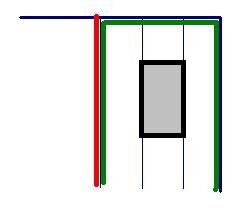I am in the planning process for a small (12'x18') rustic (off-grid) weekend cabin in southern Ohio. The goal is a CHEAP place for us to stay until we build a real house on the 21 acres my husband inherited. There is no entity with the authority to enforce the residential code (I asked a building code question of the state and was informed as such) and it's only slightly larger than the "don't need a permit" line (200sf) anyway) for this county.
A small, old wood stove has been offered to us. It is approximately 1' wide and 2' deep. Older than dirt, thus, "unlisted". I've been looking around at clearance specs until my head hurt. I get how to reduce the clearances on two (full wall sides, say back and right). What I would like to do is built a half-height wall on the left to keep my clumsy self and clumsy child from tripping into it from the side. I keep seeing "alcove warnings". Is this a reasonable thing to do, if the half-height wall is protected in the same way (vented airspace with masonry wall covering, wall height in this case) the full height walls are?
I drew a quick pic with Paint. The thick blue lines are exterior walls, the red is the proposed half-height wall, the green is the vented masonry wall, the grey box is the stove. Is this ok or not? Suggestions?
A small, old wood stove has been offered to us. It is approximately 1' wide and 2' deep. Older than dirt, thus, "unlisted". I've been looking around at clearance specs until my head hurt. I get how to reduce the clearances on two (full wall sides, say back and right). What I would like to do is built a half-height wall on the left to keep my clumsy self and clumsy child from tripping into it from the side. I keep seeing "alcove warnings". Is this a reasonable thing to do, if the half-height wall is protected in the same way (vented airspace with masonry wall covering, wall height in this case) the full height walls are?
I drew a quick pic with Paint. The thick blue lines are exterior walls, the red is the proposed half-height wall, the green is the vented masonry wall, the grey box is the stove. Is this ok or not? Suggestions?


